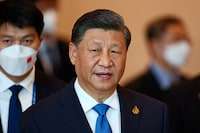John Pomfret was the bureau chief of The Washington Post in China from 1997-2003. His latest book is “From Warsaw With Love: Polish Spies, the CIA, and the Forging of an Unlikely Alliance.”
Xi Jinping will crack down on the protesters. The only question is how.

Once upon a time people might have fantasized that — as one Western journalist put it in February 1989 — “Like the bamboo shoots that emerge everywhere after a spring rain, … democracy is sprouting again in China.”
But as time has passed, the Chinese Communist Party has killed many protesters and incarcerated many more. It’s flattened a religion — Falun Gong — and even allegedly harvested organs from adherents who had been jailed and then executed.
So, if the protests continue, Xi will order a crackdown and it will probably work. On Tuesday, his minions took the first step: blaming the West. The official Xinhua News Agency reported that the CCP’s Central Political and Legal Affairs Commission met and decided to “resolutely crack down on infiltration and sabotage activities by [foreign] hostile forces …, resolutely crack down on illegal and criminal acts that disrupt social order, and effectively maintain overall social stability.” In addition, new restrictions announced by the Cyberspace Administration of China make the harmless act of “liking” something on the web into a criminal offense. People literally could be held responsible for an emoji.
Things have changed substantially in China since the last time protests directed at the central government occurred in so many places simultaneously. That was the spring of 1989, as students and workers gathered by the hundreds of thousands in Beijing’s Tiananmen Square and other public spaces around the country to call for democratic reforms. Working for the Associated Press, I covered months of protests that ended, on the night of June 3 and early morning June 4, with a military crackdown that killed hundreds, if not thousands, of demonstrators.
I was in China a decade later as well when on April 25, 1999, tens of thousands of Falun Gong adherents surrounded the Zhongnanhai leadership compound in Beijing and conducted a peaceful sit-down protest. That display of public defiance ultimately triggered a multiyear, largely successful campaign to wipe out any public vestiges of Falun Gong inside China.
Beijing has more means to suppress protests than existed in 1989 or 1999. The People’s Republic has built a digital panopticon and social control system unrivaled by even the dystopian visions of 20th-century novelists (think Aldous Huxley or George Orwell).
China’s internal security apparatus, funded by a budget that exceeds even the military’s, monitors hundreds of millions of artificial-intelligence-enabled public cameras across the country. Armies of human and algorithmic censors can access the smartphone apps that China’s citizenry rely on to communicate, travel and purchase necessities.
Chinese police also have availed themselves of billions of dollars’ worth of anti-riot gear that wasn’t available to security forces in 1989, and which offer means of coercive suppression short of opening fire on crowds. In fact, China has turned into a major exporter of anti-riot gear.
China’s relations with the West have changed, too. Most significantly — despite all the talk these days of decoupling — Western businesses are far more embedded in China’s economy and its supply chains than they were in decades past.
One of the main centers of protest this time around has been Foxconn’s giant iPhone plant in Zhengzhou. The spate of unrest began there on Nov. 23, when workers angry over unpaid wages and covid-19 lockdowns clashed with truncheon-wielding, hazmat-clad riot police. The violence followed disturbances last month that resulted in thousands of workers fleeing the facility after a covid outbreak and a botched attempt at a “closed-loop” lockdown aimed at keeping workers isolated from the outside world. But plant administrators failed to deliver adequate food and water to the 200,000 workers living there, sparking unrest. Workers were lured back to the plant with the promise of higher pay, a deal that the factory administrators then allegedly broke.
The twin crises pulled Apple — literally and reputationally — into the middle of China’s zero covid imbroglio, prompting the firm to announce that customers will face “longer wait times” for iPhone 14 deliveries even as Apple was committed, it insisted, to “ensuring the health and safety of every worker.” If the protests spread, Apple won’t be the only Western business sullied by the mess.
Amid all the changes, however, one thing hasn’t budged: the appetite for brutality at the apex of the Chinese Communist Party.
Xi detailed his views on the events of 1989 in a speech to the Sixth Plenum a year ago, giving no hint of squeamishness about Deng Xiaoping’s resort to bloodshed on June 3-4, 1989. As Xi said, “Our party … with resolute will and historical responsibility, took decisive measures, won this struggle for the survival of the Party and country, and withstood the pressure of Western countries.” Without the crackdown, Xi said the specter of socialism would’ve been left to “wander in the dark for a long period, and the process of Great Rejuvenation of the Chinese Nation would also certainly be interrupted.” Xi won’t let that happen this time and he has the tools of dictatorship to prevent it.






